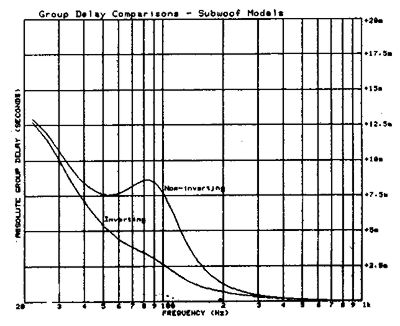| Columns Retired Columns & Blogs |
Spica TC-50 loudspeaker Page 2
The reasoning behind this thinking is summarized in three graphs. Figs.1 & 2 show the group delay of an inverting and noninverting Servo-Subwoofer; the inverting unit is clearly better. Fig.3 shows the combined frequency response of a properly set up Spica Servo-Subwoofer and TC-50 speaker, using Spica's 100Hz crossover. These graphic results are good by any standard, and provide just a hint of the amount of sophisticated modeling and experimentation that has gone into the Spica Servo-Subwoofers.

Fig.1 Spica TC-50 with Servo-Subwoofer, calculated group delay vs frequency with subwoofer inverted and non-inverted (2.5ms/vertical div.).

Fig.2 Spica TC-50 with Servo-Subwoofer, calculated amplitude vs frequency with subwoofer inverted and non-inverted (1dB/vertical div.).

Fig.3 Spica TC-50 with Servo-Subwoofer, overall frequency and phase responses with optimized crossover (3dB/vertical division).
My problem with all this technical elegance is that I don't hear what Spica measures. What I hear is a Servo-Subwoofer that never really seems wholly dynamic or lifelike, where the dynamic energy in the upper bass and lower midrange seems to be strangely lacking.
Further, I found the imaging to be uncertain unless the TC-50s and Servo-Subwoofers were aligned exactly as instructed by the manufacturer. Necessarily, the listening area within which the alignment was correct is relatively small. Set-up is therefore extremely critical: any error makes the vague impression of sonic confusion worse.
I also cannot endorse the use of a single Spica Servo-Subwoofer. It is almost impossible to get the system to image anywhere near as well as without a subwoofer. The upper rolloff of the Servo-Subwoofer isn't sharp enough to permit the use of one of them without considerable confusion in the imaging and lower midrange; I would much rather hear the TC-50s by themselves. If I was slightly uneasy about system integration with two Servo-Subwoofers, I was just plain uncomfortable with only one Servo-Subwoofer.
I can see how an existing owner of a TC-50 might well go for two Servo-Subwoofers. The result may not be perfect, but it is a pleasant combination and its errors are made in the direction of making music a bit softer and more forgiving than it should be. Many recordings will benefit from such sound characteristics.
I also can see how the resulting added power-handling capability, and extension into the deep bass, would seduce any TC-50 owner. The problems in the upper bass, and with bass dynamics, are subtle, and the change in upper-octave balance is likely to be euphonic with most phono records and virtually all CDs.
Even so, the cost of two Servo-Subwoofers ($1190) would make me think twice—even if I already owned a pair of TC-50s. I'd be tempted either to sell them, or use them as a second speaker system. There is simply not the same coherence, dynamic realism, and conviction you can get with a similar investment in Thiel or Vandersteen speakers.
I also can't help wondering if there isn't another parameter that needs to be included in Spica's analytic effort. I'd bet a whole wooden nickel that further investigation will reveal that significant improvements are possible.—Anthony H. Cordesman
- Log in or register to post comments




































